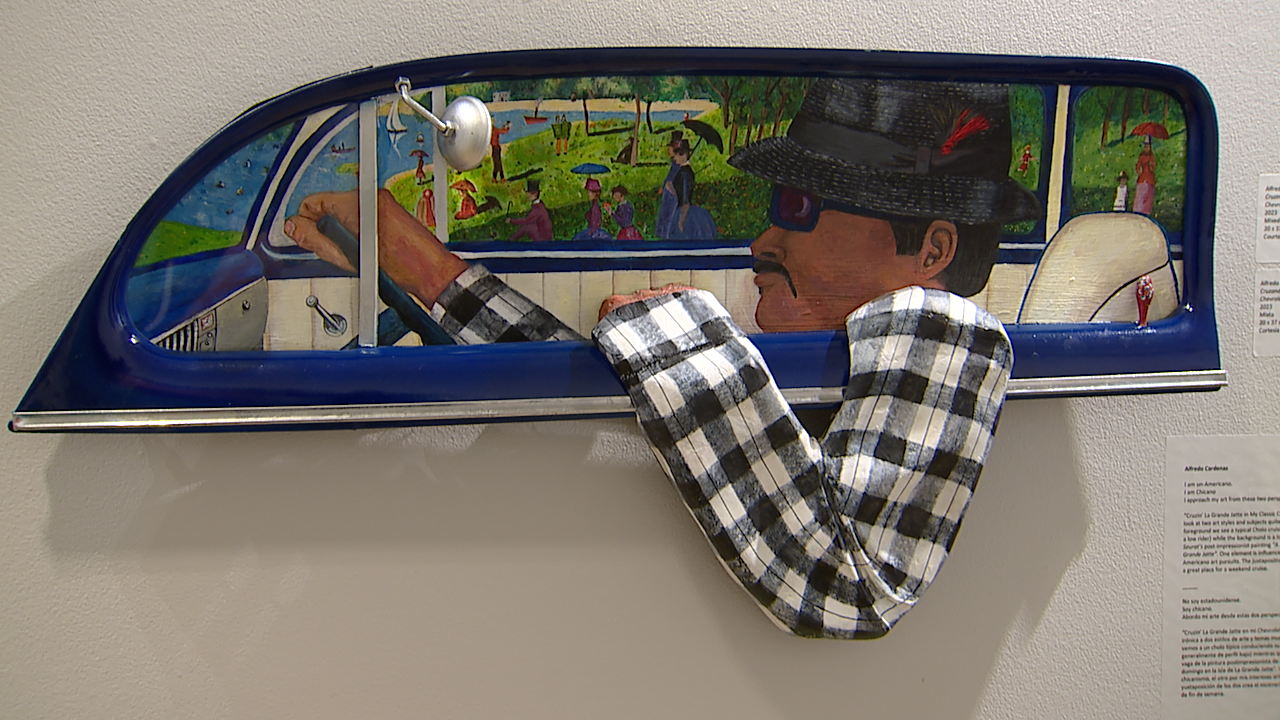FORT COLLINS, Colo. — An ancient word is inspiring fresh creativity, and a diverse display of Mexican-American culture, at an art exhibit in northern Colorado.
“Nepantla, even though it’s a Nahuatl word,” spoken by the Aztecs, “it's a universal theme,” said Tony Ortega, a Denver artist who curated the exhibit under that theme.
Nepantla means the space in between.
“That's a concept that many Mexican-Americans feel,” he said. Trying to preserve their heritage, while living in the United States.

“By acknowledging our history, from indigenous roots to colonial roots to contemporary times, I'm expressing that space in between, that space of Nepantla,” he said.
While some might “pigeonhole” the exhibit, believing a collection of Mexican-American art would be one-dimensional. Ortega said he brought together artists from multiple generations, with different techniques, mediums and perspectives.

Hispanic Heritage
Hispanos' unique art lives on in Colorado hundreds of years later
“What I'm hoping people come away with from this exhibit is that they see the diversity,” he said.
Some of the artwork depicts indigenous symbols and religious figures, some the Catholicism of Spanish settlers known as Hispanos. Others use vibrant colors and repurposed materials to portray more modern experiences.

Ortega’s woodblock prints explore the old and the new, through a mix of techniques and images.
He creates the images in Photoshop, then sends the designs to a laser cutter who carves them into a wood slab.
Ortega rolls ink onto the woodblock, places a sheet of paper on top and runs it through a press. He gets the paper from the Mexican state of Puebla where “their ancestors have been making this paper since pre-Columbian times,” he said.

His print called Nepantla shows a Cholo, who he describes as “kind of a hip, savvy young person.”
“His sleeves are rolled up. He's ready to work, right? He's ready to share culture,” Ortega said.
The Cholo is surrounded by Mayan glyphs. Next to him is a Chevy Impala lowrider. On his bandana, Ortega added a Mickey Mouse whose face is painted for Day of the Dead. “I call him Mickey Muerto,” he said.

Standing next to the Cholo is an Adelita, a name for women who fought in the Mexican Revolution. She’s holding her rifle, “but she also has the aura of Our Lady of Guadalupe behind her” and an angel at her feet.
Ortega said the “cultural hybridity” of his art captures that space in between all of these influences on Mexican-Americans, also known as Chicanos.

Hispanic Heritage
Denver Mariachi group shares Mexican culture through music
Ortega said he and many of the other artists draw inspiration from the Chicano movement of the 1960s and 70s, which emphasized connecting with the past to understand yourself.
“I'm mixing cultures, trying to ask questions,” he said, as are the other artists in the exhibit.

Alfredo Cardenas repurposed an old car window frame to depict a Cholo driving through art history. He calls it “Cruzin’ La Grande Jatte in my Classic Chevrolet.” The view out of his car window is Georges Seurat’s post-impressionist painting “A Sunday Afternoon on the Island of La Grande Jatte.”
Anita Rodriguez brings a new twist on the elaborate frames of classic Santero art. Standing in front of an adobe home in the Southwestern desert, a skeleton bride and groom are ready to drive off in their car, which appears to be grinning.
“It adds a little element of magical realism or other worldliness,” Ortega said. “In magical realism, with the living are the saints, are the angels, the dead. Our ancestors are all there at the same time.”

The exhibit also explores how technology is shaping a new reality for Mexican-Americans.
Quintin Gonzalez explores possible dystopian futures or utopian worlds by uploading his own images into an Artificial Intelligence program. After running prompts through the generative algorithms, Gonzalez edits the images again.

“There's still the hand of the artist there, even though everything's done via computer,” Ortega said. “Technology has always been a part of the art world, and it changes us as artists, and it changes our work.”
The Nepantla exhibit is open until January 5 at the Museum of Art Fort Collins.

The museum is also hosting workshops, classes and lectures with some of the artists. Tony Ortega will teach a day camp on making papier-mâché animal sculptures known as Alebrijes. Angel Estrada will teach how to make "decorative picture frames for pictures of loved ones alive or past." And Cipriano Ortega will explore poetic magical realism.





Denver7 is committed to making a difference in our community by standing up for what's right, listening, lending a helping hand and following through on promises. See that work in action, in the videos above.



